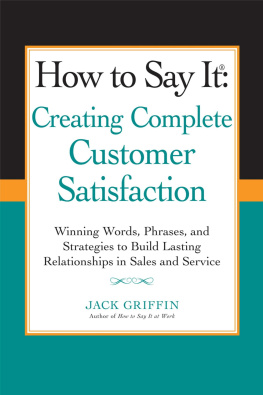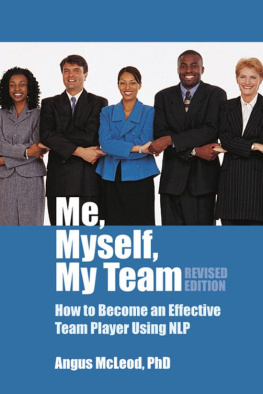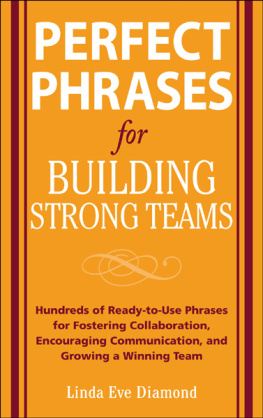Table of Contents
To Flora
WHY THIS BOOK IS FOR YOU
When you speak, speak as if your life depended on it. Because it doesat least when youre on the job. Maybe what you communicate will make the difference between being able to pay your rent this month and not. Maybe it will make the difference between paying rent and owning a house, or between having one house in the city and another by the lake. Or perhaps it will be the difference between a job and a career: spending your time and drawing a check or turning time into self-fulfillment, satisfaction, and a fat wallet. In business, the way you put yourself across is always about getting something you need or something you want. Its about making a difference in your life and the lives of those who depend on you.
Putting yourself across. Nothing you do in business is more important. And you have to do it every day. Good thing youve gotten hold of this book: the complete guide to power words and phrases, body language, and communication secrets. With it, you can explore strategies and ready-to-use models of verbal and nonverbal communication designed to be effective for todays businessperson. This revised edition of How to Say It at Work is a contemporary guide to persuasion, offering a minimum of theoretical speculation and a maximum of practical tips, advice, and examples taken from the real world for use in the real world, whether you are communicating face to face or through cyberspace.
Real Communication Tools for the Real World
This book provides the tools for successful real-world communication and the techniques for applying them. Along the way, youll also find diagnostic self-tests designed to save you time by helping you pinpoint just what skills you need to hone to make you consistently more effective as a communicator. Lets go back to that phrase real world for just a moment. Tools and techniques are just fine, but they dont do much good unless they are actually used. At every step of the way, this book shows you how to apply the tools you acquire to specific business situations. The emphasis here is on practice rather than theory.
The tools and techniques youll acquire are of two kinds: equipment to prepare for communication, and equipment you need when the time actually comes to put yourself across. In Part I you will find a special test to help you determine just how effective your current communications skills areand this includes your verbal as well as nonverbal chops. You will also be introduced to a core set of the words and phrases that should be a part of every business vocabulary.
Secrets of Nonverbal Communication
Effective communication is a lot more than a gift for gab. One of the paradoxes of our technically and culturally advanced civilization is that, as we have become more sophisticated, we have increasingly come to recognize how much in our highly mechanized, apparently abstract, and hyperintellectualized daily lives is dependent on primitive, primal, or unconscious motives, forces, and signals. Of course, all of us learn at a very early age that people sometimes say one thing while meaning another. Sometimes, when they do this, they actually believe theyre telling the truth. Sometimes, theyre deliberately lying. And at other times still, we can just look at a person, and we knowwere convincedhe believes passionately in each and every word he utters. The person looks convincing, we say, and maybe we wish we could always be assured of looking that way when we have something important to communicate. Because its a fact: The most effective, moving, and persuasive communication happens when verbal and nonverbal signals are in perfect sync. The result is communication synergy. For this reason, Part I of How to Say It at Work includes a special set of tools to help you build not only your verbal, but your nonverbal vocabulary: the looks and gestures by which we often telegraph our real message.
Part I also includes a checklist for effective communication. Use it to assist you to define your objectives, clarify your goals, and illuminate your options before you open your mouth to speak. Complete it, then move on to chapters covering the art of disagreeing without being disagreeable and everything you need to know about communicating online, including email and instant messaging.
How to Handle Specific Situations and People
Part IIthe rest of the bookshows you how to put yourself across in every major business situation and to all the key players in business: supervisors, colleagues, subordinates, clients and customers, vendors and suppliers, and creditors and investors, as well as lawyers and agents and agencies of government at every level. Included are full chapters devoted to getting a great job for yourself and to hiring a great employee for your firm. Each chapter begins with a brief and highly revealing opportunity to Self-Test Your Savvy, so that youll know where you are before you begin. Then, instead of making you slog through theory and speculationyou just dont have the time for thatyou get lists of power words and phrases that are specific to the person or situation covered in the chapter. Next come the words and phrases to avoid, the pitfalls that can sabotage any negotiation, deal, or critical conversation. Two concise discussions follow: Body Language Strategy and Body Language to Avoid. As with the power words and phrases lists, both of these are carefully geared to the specific situations and persons treated in the chapter.
After covering these essentials, each chapter launches into an in-depth consideration of the most effective steps and strategies in a given situation. The emphasis is always on examples and ready-to-use models for communication. Wherever possible, brief scripts are included to help you do what great communicators have always done: prepare to be spontaneous.
Finally, because How to Say It at Work was written for the real world, we confront the tough issues, ranging from overcoming indifference to handling hostility to dealing with inappropriate, unfair, even abusive behavior.
Mastering the Magic of Communication
Think of How to Say It at Work as a manual of magic. Successful communication transforms your thoughts, will, and desires into action. It moves people. It transforms the thoughts, will, and desires of others. What better word for this process than magic?
But as with most magic, there is really nothing supernatural about it. The apparent miracles of communication are worked by means of tools skillfully handled. And just about anyone can acquire the tools and become proficient in the techniques of using them. Its a matter of knowing how to think through goals and objectives, then practicing how to become conscious of the combined effect of the words and the nonverbal signals we receive and broadcast every day. This book will guide youquickly and practicallythrough that process of self-awareness. What I can promise you is that learning to put yourself across will be both personally and professionally profitable.
Part I
Setting the Stage for Communication Success
CHAPTER 1
HOW GOOD ARE YOU AT PUTTING YOURSELF ACROSS?
Self-Test Your Communication Effectiveness










